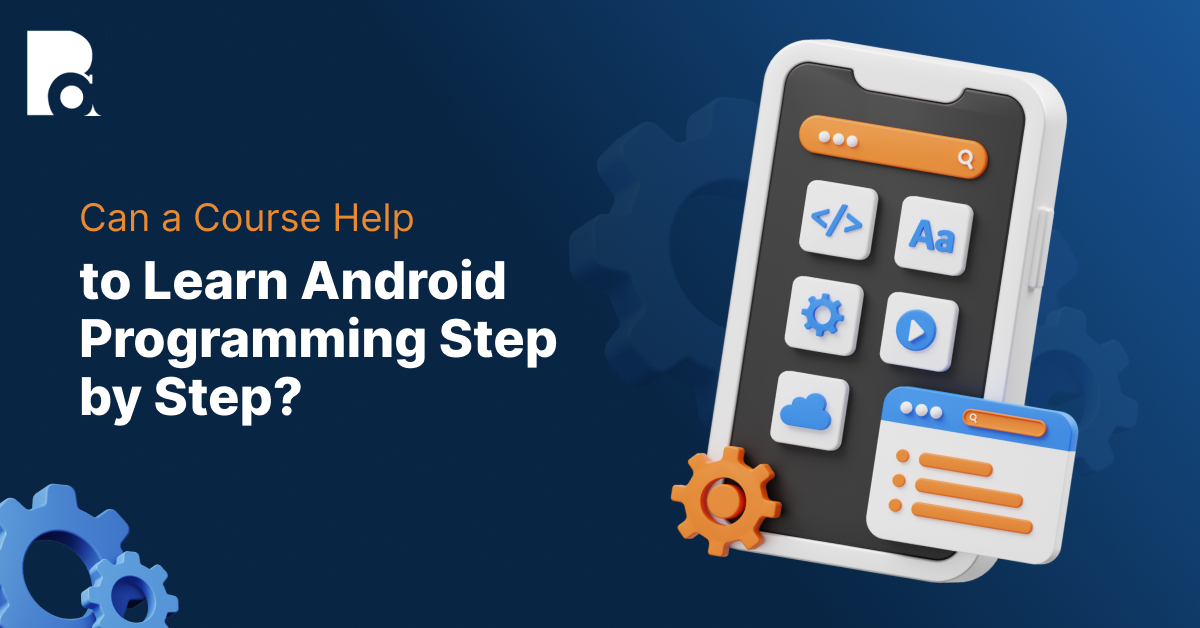
Can a Course Help to Learn Android Programming Step by Step?
Android powers 70% of the world’s smartphones. So, if you are dreaming about a career in Android programming, that would be a smart move. With the requisite skills and experience, candidates can expect in-demand, high-paying jobs that offer job security. Given that technology is continually advancing, as an Android developer, you will get to work on innovative, cutting-edge projects.
If you plan to learn Android programming from a well structured course, you will build the technical and practical skills that employers seek.
Learn Android Programming Step by Step- What a Course Will Teach You
Setting Up Your Environment: Android Studio and SDKs
The first step is setting up Android Studio, the primary tool for Android development. A good course teaches you how to install the necessary SDKs, configure emulators, and navigate Android Studio’s features. You’ll learn how to create your first project, explore the file structure, and run basic programs. This setup process helps you become comfortable with the environment where all your coding will take place, ensuring you’re not lost later.
Grasping the Basics of App Architecture
A course introduces you to Android’s architecture—how apps are structured using activities, fragments, layouts, and views. You’ll understand what each screen (activity) in an app does and how users interact with different components. Early lessons teach you how to define layouts in XML, which acts as a blueprint for your app’s user interface, ensuring a logical flow in the design.
Mastering User Inputs and UI Components
The user interface of an app is what every app is made of. At this point, you’ll be trained in how to create interactive components like buttons, text fields, checkboxes, or spinners. You will also be taught about event handling where you can learn how to respond to app users actions. You’ll be introduced to Android XML layouts, which is simply the creation of responsive UIs that optimize according to the display screen being used.
Managing App Data with Storage Solutions
User data of most applications is stored locally or online. Students will be shown details about several storage options like, SharedPreferences for small data, SQLite databases for structured local data, and external APIs for online storage.
Learning Android programming step-by-step gives you a safety net. Instead of being paralyzed by how much you don’t know yet, you get to focus on small, digestible pieces that you can master one by one.
Introducing Networking and APIs
To build dynamic apps, students will learn API integration. Trainers will teach you how to fetch real-time data such as weather conditions or stock prices using an HTTP request and then show that data in your app. In this part, you will have hands-on experience while using certain libraries. These libraries really make things easier for you when it comes to connecting your app with the outside world.
Debugging and Troubleshooting Skills
While no one will write perfect code on the first attempt, an Android programming course can teach you how to find and fix bugs. Instead of spending hours looking for a problem, you’ll learn to use Android Studio’s debugging tools to go through your code line by line. You will also learn how to write test cases so that every new feature you add doesn’t accidentally break something else in your app.
Version Control with Git and GitHub
Other than learning to write code you would need to be familiar with version control systems to manage code changes and collaborate. Through these systems, students get to know the workflows used in the industry. On platforms like Git and GitHub you will learn how to track versions of your code, create branches, and resolve conflicts. These tools are essential whether you’re working alone or as part of a team.
Adapting to Kotlin
No modern Android programming course would be complete without covering Kotlin. What is Kotlin? Kotlin was officially endorsed by Google for use as the preferred language in Android development. In fact, the Kotlin programming language has several advantages over Java: more concise syntax, fewer chances of runtime errors, and built-in null safety, which prevents those annoying “null pointer exceptions” capable of crashing apps.
Most likely, you will start with Java, to get a taste of the traditional structure in Android, moving towards Kotlin as you go further. Getting to learn Kotlin for Android gives another dimension to mobile development. For instance, what might take an entire 10 lines to implement in Java can be done in two lines in Kotlin. That minimizes boilerplate code, making life easier for less experienced folks who don’t have to spend too much time on syntax but the logic behind an application.
Moreover, the interoperability of Kotlin with Java means that you won’t waste the older knowledge you gain. Android programming trainers will show you how both languages can coexist within the same project, teaching you to maintain and extend legacy codebases. Further into the course, you’ll also explore Kotlin-specific features, like coroutines, which simplify working with tasks that run asynchronously, such as downloading data in the background.
Even if you begin to learn Kotlin for Android development, down the line you will have a lot of opportunities as Kotlin is also being used in non-Android projects like cross-platform apps, backend development and so on.
Android’s Unique Ecosystem: Device Compatibility
Developing for Android means handling various devices, screen sizes, and Android versions. A course teaches you best practices for designing responsive UIs and ensuring backward compatibility. You’ll learn how to use resources like density-independent pixels (dp) and version checks to make your app accessible across devices.
Testing and Quality Assurance
Courses cover testing techniques to ensure your app functions reliably. You’ll learn how to write unit tests, automate testing, and simulate different user interactions. This phase emphasizes the importance of maintaining high-quality apps that perform consistently across devices and scenarios.
Hands-on Projects
These projects simulate real-world applications, so you will be applying the concepts that you learn in a practical way. Instead of sitting through tutorials passively, you will perhaps be given the task to create a weather app to figure out how to use API integration or a task manager app to learn how local data is stored. Such assignments give you a sense of actual problem-solving in mobile development.
Not only will these practical assignments reinforce your learning, but they will also develop your portfolio. Impressive portfolios allow job seekers to stand out from the competition while applying for jobs and freelance work. From setting up activities to debugging code, each of the steps teaches you to think like a developer. And as you progressively work on projects, you gain more confidence in your skills.
Portfolio Building
A good course teaches you not only technical skills but also allows you to build a portfolio. Here, you can showcase your abilities when applying for jobs or pitching to freelance clients. This portfolio demonstrates not just your coding skills but your ability to solve real-world problems.
The skills you gain from an Android programming course will give you the confidence you need to ace your job interviews and secure high-paying careers in the IT sector.
